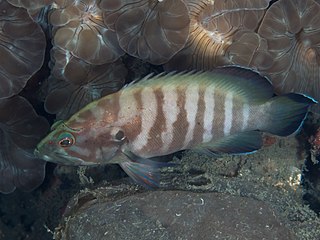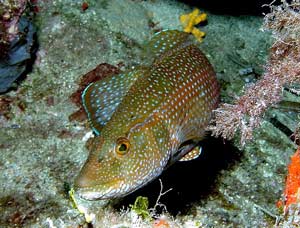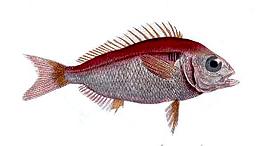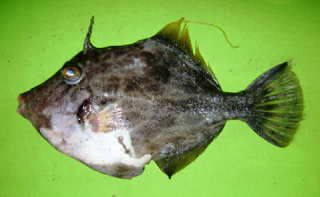
The ballan wrasse is a species of marine ray finned fish from the family Labridae, the wrasses. It is found in the eastern Atlantic Ocean, where it inhabits rocky areas. Like many wrasse species, it is a protogynous hermaphrodite—all fish start life as females, and some dominant fish later become males. It is used as a food fish in some areas and it is also finding use as a cleaner fish in the aquaculture of Atlantic salmon in northwestern Europe.

The grey triggerfish or gray triggerfish, is a ray-finned fish in the triggerfish family. The species is native to shallow parts of the western Atlantic from Nova Scotia to Argentina and also the eastern Atlantic, the Mediterranean Sea and off Angola on the west coast of Africa.

The thornback ray, or thornback skate, is a species of ray fish in the family Rajidae.

Cephalopholis boenak, the chocolate hind, brownbarred rockcod, brown-banded cod or brown-banded rockcod, is a species of marine ray-finned fish, a grouper from the subfamily Epinephelinae which is in the family Serranidae which also includes the anthias and sea basses. It is associated with reefs over a wide Indo-Pacific distribution. It is an important species for commercial fisheries in some parts of its range.

The European flounder is a flatfish of European coastal waters from the White Sea in the north to the Mediterranean and the Black Sea in the south. It has been introduced into the United States and Canada accidentally through transport in ballast water. It is caught and used for human consumption.

The shrimp scad, is a species of widespread tropical marine fish of the jack family, Carangidae. The shrimp scad is widely distributed in the tropical and subtropical western Indian Ocean and areas of the eastern Pacific Ocean, ranging from South Africa in the west to Hawaii in the east, including Japan and Australia to the north and south. The species is commonly found on inshore reefs and sandy substrates. It has the common body profile of a scad, and may be difficult to differentiate from others in the genus Alepes. It is one of the larger scads, growing to 40 cm, but often is encountered at much smaller sizes. The shrimp scad often forms large schools, and is carnivorous, consuming a variety of crustaceans and small fish. It is of moderate importance to fisheries throughout its range.

The Christmas wrasse, also known as the ladder wrasse, green-barred wrasse or green-blocked wrasse, is a species of ray-finned fish, a wrasse from the family Labridae which is native to the Indian Ocean and the western Pacific Ocean. It inhabits shallow reefs at depths from the surface to 10 m (33 ft). It is of minor importance to local commercial fisheries and can be found in the aquarium trade.

The shagreen ray, also known as shagreen skate or fuller's ray, is a species of skate in the family Rajidae. This ray is found in the eastern Atlantic Ocean, from Murmansk, Russia through Norway, southern Iceland, the Faroe Islands, the Celtic Sea, the northern North Sea and Skagerrak, to northern Morocco, including (infrequently) the western Mediterranean Sea and the Madeira Islands. It is absent from the shallow waters off England and Wales.

The ornate wrasse, Thalassoma pavo, is a species of wrasse native to the rocky coasts of the eastern Atlantic Ocean and the Mediterranean Sea. This species is of minor importance to local commercial fisheries, is also popular as a game fish, and can be found in the aquarium trade.

Labrus viridis is a species of wrasse native to the eastern Atlantic Ocean from Portugal to Morocco, as well as through the Mediterranean Sea to the Black Sea. This species is found around rocky reefs amongst the rocks or in eelgrass beds. It can reach 47 cm (19 in) in standard length, though most do not exceed 37.5 cm (15 in). It is one of several species called green wrasse.

The East Atlantic peacock wrasse is a species of wrasse native to the eastern Atlantic Ocean from Spain to Morocco and in the coastal waters of the Mediterranean Sea and the Black Sea. This species lives around rocks surrounded by eelgrass and can also be found in brackish waters in lagoons. It occurs at depths from 1 to 50 m. This species can reach 44 cm (17 in) in standard length, though most grow no larger than 25 cm (9.8 in). This species is sought as a game fish and is also important to local peoples as a food fish. It can also be found in the aquarium trade.

Stegastes leucostictus is a species of damselfish found near the sea bed in shallow waters on the western fringes of the Atlantic Ocean. It is commonly known as the beau gregory or beaugregory.
The yellowmouth grouper, also known as the crossband rockfish, grey mannock, hamlet, harlequin rockfish, princess rockfish, rockfish, salmon grouper, salmon rock fish or scamp, is a species of marine ray-finned fish, a grouper from the subfamily Epinephelinae which is part of the family Serranidae, which also includes the anthias and sea basses. It is found in the Caribbean and in the tropical waters of the Atlantic Ocean. It is also found in pockets in Brazil. It is a fairly large fish and it gets its name from the yellow around its mouth.

The blackspot seabream, also known as the red seabream, is a marine ray-finned fish species in family Sparidae. It is widespread in the Eastern Atlantic from Norway to Mauritania, including Macaronesia and the western Mediterranean.
Halichoeres richmondi, commonly called the Richmond's wrasse or chain-lined wrasse, is a fish species in the wrasse family native from the central Indo-Pacific.

Sphyraena chrysotaenia, the yellowstripe barracuda, is a species of predatory, ray finned fish from the family Sphyraenidae which is found in the Indo-West Pacific region. It has entered the Mediterranean Sea from the Red Sea through the Suez Canal as a Lessepesian migrant and is now an important species in the fisheries of the eastern Mediterranean.

Stephanolepis diaspros, commonly known as the reticulated filefish or the reticulated leatherjacket, is a species of bony fish, a ray-finned fish in the family Monacanthidae. Its natural range is the western Indian Ocean but it is also one of the species which has colonised the Mediterranean through the Suez Canal by Lessepsian migration from the Red Sea.

The blackear wrasse is a species of wrasse, a type of fish in the family Labridae, from the warmer waters of the western Atlantic Ocean.
Symphodus caeruleus is a species of marine ray-finned fish, a wrasse from the family Labridae. It is endemic to the Azores in the eastern Atlantic Ocean.

The lesser African threadfin is a species of marine ray-finned fish, a threadfin from the family Polynemidae which is found in the eastern Atlantic Ocean off the western coast of Africa.


















